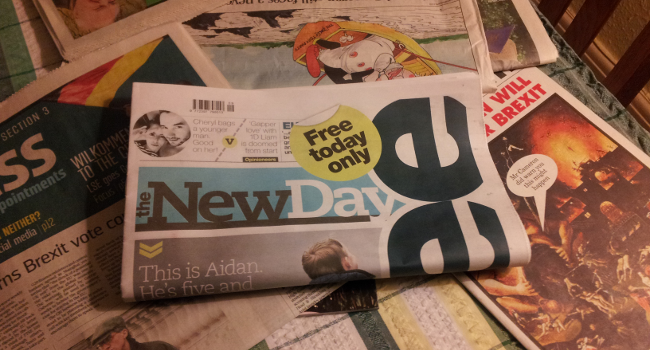It is perhaps the defining hypocrisy of journalism that while the industry claims to be dedicated to popping the pretensions of the great windbags of our time, the trade rarely misses a chance to puff itself.
So it’s hard not to snigger at the claim of the New Day, the first national paper to be launched in Britain for some 30 years, to be “a new type of newspaper”.
Admittedly it lacks a few features that have been taken as a given.
There are no weekly columnists, for a start. Sports are in the middle rather than at the back. And there is allegedly “no political bias”, or even leader columns, despite the paper hailing from the offices of the Mirror and drawing on Trinity Mirror resources.
(Actually every decision about what to print indicates bias. At some point I’ll bore you at length on this.)
Inside New Day follows the template gamely tried by the Independent, which is readying itself for its last print run later this March, mixing in news and features haphazardly rather than following the domestic-comment-foreign-sport delineations preferred by many.
And that is probably no coincidence, the paper having been announced shortly after the Indy’s owners said they would be pulling the print edition and selling the cut-price i to local news specialist Johnston Press.
Where exactly New Day sits in the market is unclear, though Press Gazette put it somewhere between the i and the freesheet Metro, published by the Daily Mail’s parent company.
Although it claims to be for both the sexes (and, one assumes, everybody else), the pitch is plainly more towards women, who seem far better accounted for on mastheads and column headers than the rougher sex.
Even in tone the news and features have a strong human interest bias, which at least to my eyes has a more feminine quality. The front page, for instance, is about young children caring for their parents.
Despite this, part of the paper’s pitch is that it will feature more “good news”, a classic trope of media criticism, though one that misses the point that bad news tends to be more interesting, probably even as a matter of raw psychology.
Though the first edition was free, the paper will be sold for 25p for the first two weeks and 50p thereafter, aiming to garner a readership of about 200,000 (half of which it apparently needs to break even).
Whether it achieves this will only tell with time, as the paper evolves and probably loses a bit of its innocence in a bid to stay standing in the bustle of Fleet Street.
Dylan Sharpe, head of public relations at the Sun, already laid into the title, telling PR Week: “It’s going to be interesting to see if people are willing to pay for a newspaper with so little news and sport coverage.”
As the New Statesman pointed out, weekly magazines that are more feature led can thrive in the print market, but the daily press is assuming that print is a losing game at this point, which makes New Day’s decision to not offer a website more striking.
The pressmen have largely been generous to Trinity Mirror’s move. But to me it seems a plan that is unlikely to pay off.
Image Credit – New Day, February 2016 by Jimmy Nicholls
